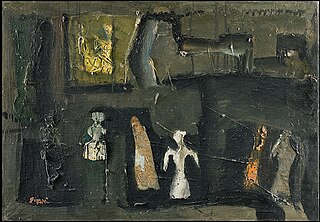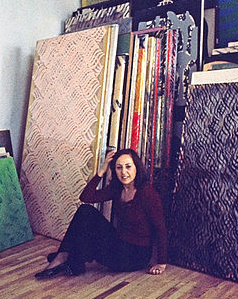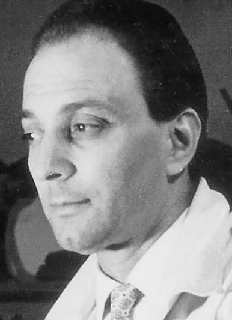
Marino Marini was an Italian sculptor and educator.

Mario Sironi was an Italian Modernist artist who was active as a painter, sculptor, illustrator, and designer. His typically somber paintings are characterized by massive, immobile forms.

The Galleria Nazionale d'Arte Moderna e Contemporanea, also known as La Galleria Nazionale, is an art museum in Rome. It was founded in 1883 on the initiative of the then minister Guido Baccelli and is dedicated to modern and contemporary art.

Alighiero Fabrizio Boetti known as Alighiero e Boetti was an Italian conceptual artist, considered to be a member of the art movement Arte Povera.

Guido Marzulli is a figurative Italian painter.
Franca Batich is an Italian contemporary artist who specializes in oil and mixed technique abstract painting.

Ketty La Rocca was an Italian artist during the 1960s and 70s. She was a leading exponent of body art and visual poetry movements.
Paolo Canevari is an Italian contemporary artist. He lives and works in New York City. Canevari presents highly recognizable, commonplace symbols in order to comment on such concept as religion, the urban myths of happiness or the major principles behind creation and destruction.

Carla Accardi was an Italian abstract painter associated with the Arte Informale and Arte Povera movements, and a founding member of the Italian art groups Forma (1947) and Continuità (1961).
Valentina Moncada di Paternò is an Italian art historian, gallery owner, and curator who specializes in contemporary art. In 1990 she opened an art gallery in Rome in Via Margutta 54, establishing herself as a talent scout due to a program of young international artists who soon became known worldwide.

Piergiorgio Colautti is a modern Italian painter and sculptor, who lived and worked in Rome. He is known for his own distinctive style, sometimes labelled "Hyperfuturism", in which figurative elements are enmeshed and submerged by symbols reflecting a cold and modern technological world.
Marina Apollonio is an Italian painter and optical artist. She lives and works in Padua.

The Galleria Comunale d'Arte Moderna is the museum of modern and contemporary art of the city of Rome, Italy. It is housed in a former Barefoot Carmelite monastery dating from the 17th century and adjacent to the church of San Giuseppe a Capo le Case, at 24 Via Francesco Crispi.
Giuseppe Veneziano is an Italian painter and one of the leading figures of Italian art groups "New Pop" and "Italian Newbrow".

The Museo di Roma is a museum in Rome, Italy, part of the network of Roman civic museums. The museum was founded in the Fascist era with the aim of documenting the local history and traditions of the "old Rome" that was rapidly disappearing, but following many donations and acquisitions of works of art is now principally an art museum. The collections initially included 120 water-colours by the nineteenth-century painter Ettore Roesler Franz of Roma sparita, "vanished Rome", later moved to the Museo di Roma in Trastevere.
Pasquale Verrusio was an Italian painter, sculptor and engraver.

Palma Bucarelli was an Italian art historian, curator and administrator, mostly known for her tenure as director of the Galleria Nazionale d'Arte Moderna (GNAM) in Rome from 1942 to 1975.

Vito Bongiorno is an Italian artist known for making art out of charcoal.

Tristano Alberti was an Italian sculptor. Inspired by Auguste René Rodin, after attending ornate sculptors class at the Alessandro Volta technical institute in Trieste, he choose the same craftsman-like approach in Early Modern Sculpture: Rodin, Degas, Matisse, Brancusi, Picasso, Gonzalez and later, in late 1940s and early 1950s, developed a fully personal style in figuratively representing human and animal-themed chalks and bronzes, possessing a unique ability to model passion, rage and strong emotions. He is known for his sacred art and monuments, and such sculptures as San Sebastiano, Cat, Nazario Sauro and San Giusto. The latter being yearly and awarded as a copy and special prize to prominent people in Trieste.
Lorenza Trucchi is an Italian journalist and art critic. Trucchi was born on Monaco. She is the daughter of Olga Cassini and Lorenzo Trucchi, a well-known surgeon who practiced his profession in the Principality.













